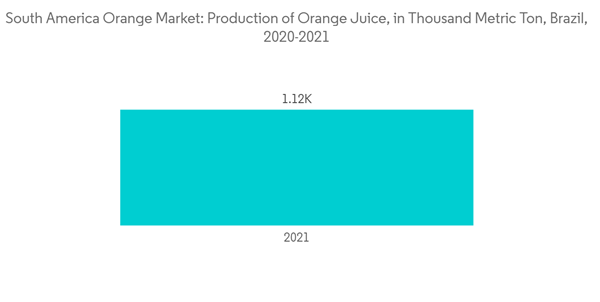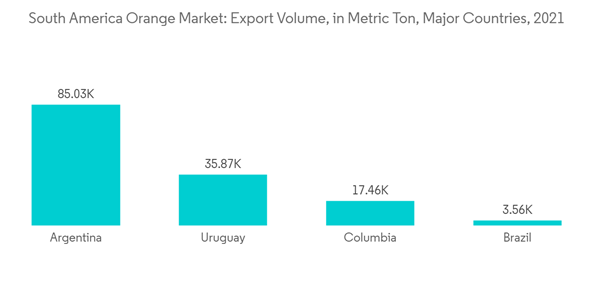The South America orange market is projected to register a CAGR of 2.8% over the forecast period.
This product will be delivered within 2 business days.
Key Highlights
- In South America, oranges are primarily used for juice production and secondarily for direct consumption. Brazil is the world's leading producer, with an 85% production share in South America. Argentina, Columbia, Paraguay, Chile, and Peru are some minor orange-producing countries. South America is also one of the prominent orange trade partners. Brazil, Argentina, and Chile are the leading exporters, whereas Paraguay and Ecuador are the leading importers of oranges.
- According to the United States Department of Agriculture (USDA) report, in the year 2021-2022, fresh orange production was expected to increase to 920,000 metric tons, up 120,000 metric tons from previous estimates. Sweet citrus is grown in Argentina's northwest (oranges) and northeast (oranges and tangerines). The main orange varieties grown in northwest Argentina are Hamlin, Pineapple, Robertson, and Navel, whereas in the northeast, they are Navel, Salustiana, and improved Valencia (Midnight, Delta Seedless). Smaller producers are struggling to compete, and when they exit the business, they tend to sell their orchards to larger farmers.
- There is a new trend of producers switching to more profitable crops, such as "yerba mate," and other activities, such as livestock production. Growers in the northeast tend to produce on smaller plot sizes than those in the northwest.
- Larger orange producers continue to replace unproductive trees and invest in genetic materials to improve yields. These replanted orchards also tend to have higher tree densities. New private-sector investments are primarily concentrating on improving efficiency in processing and packing facilities, irrigation, and research and development projects. Some factory retrofitting is taking place as exporters look to expand cold-chain capacity to meet export market requirements.
- In the past few years, citrus exporters made additional investments to comply with protocols required by new export markets, such as the United States and China, and to meet the European Union (EU) citrus black spot (CBS) requirements to prevent further detections.
South America Orange Market Trends
Brazilian Orange Drives the Food and Beverage Industry
- The Brazilian orange crop for 2022-23 is forecasted at 405 million 40.8-kg boxes (MBx), equal to 16.52 million metric tons, a 2% reduction relative to the current season. Sao Paulo and Minas Gerais are commercial citrus belts for processing in the food and beverage industry. The Sao Paulo industry is expected to process 265 million boxes of oranges for orange juice production, accounting for 1.027 metric tons of juice. Other producing states should deliver 24 million boxes, accounting for 96,000 metric tons of juice.
- Production of Brazilian frozen concentrated orange juice (FCOJ) is estimated at 1.12 million metric tons in 2022-23, a drop of 1% from the prior year. According to a United States Department of Agriculture-Foreign Agricultural Service (USDA FAS) Brazilian citrus report, the reduction is due to the lower fruit availability for processing. Total Brazilian FCOJ export for 2022-23 is estimated at 1.04 million metric tons, similar to 2021-22 (1.06 million metric tons). The Sao Paulo industry should contribute 1.01 metric tonnes of that total.
- Total Brazilian FCOJ 65 Brix equivalent export for 2022-23 is estimated at 1.04 million metric tons, similar to the revised figure for 2021-22. The production of orange juice in Sao Paulo for 2022 was at 1.12 million metric tons, an increase of 16% compared to orange juice production for 2021. This was due to the expected higher availability of fruit for processing.
- Sao Paulo projects domestic FCOJ equivalent consumption for 2022-23 at 80,000 metric tons, 65 Brix, up 5,000 metric tons compared to 2021-22 (75,000 metric tons), given that orange juice consumption has steadily increased in Brazil.
Rising Export of Oranges in European and North American Countries
- South America's top fresh orange exporting countries are Chile, Argentina, Uruguay, Columbia, and Brazil. Brazil is one of the leading exporters of orange juice but has yet to become a prominent exporter of fresh fruits. Major exporting partners of these countries are the United States and many other European countries, such as Belgium, Spain, Greece, the Netherlands, Italy, and France. Key importers in these regions are the orange juice industries due to the quality of the fruit, which is suitable for preparing juice.
- According to the United States Department of Agriculture (USDA) report, in the year 2021, the cumulative exports to the United States from July-November 2021 were 211,560 metric tons, an increase of 25% relative to the same period during the previous year with 62,745 metric tons likely pushed by the decrease in the Floridian production for the year 2022. In addition, the European Union remains the largest export destination of Brazilian orange juice, with approximately 70% of total exports.
- In Chile, the orange marketing year starts April with the beginning of the harvest season. The bulk of Chilean orange export occurs between July and September each year and peaks around August. In 2022, monthly orange exports during the peak months were lower than in the same period in 2021. In 2021, Chile exported 104,714 metric tons of oranges to the world, a 16.4% increase over the previous year. Chile exports oranges to various other countries, such as Ecuador, the Dominican Republic, and Canada, but in smaller quantities than the volumes shipped to the United States.
South America Orange Industry Overview
Additional Benefits:
- The market estimate (ME) sheet in Excel format
- 3 months of analyst support
This product will be delivered within 2 business days.
Table of Contents
1 INTRODUCTION
4 MARKET DYNAMICS
5 MARKET SEGMENTATION
Methodology

LOADING...










